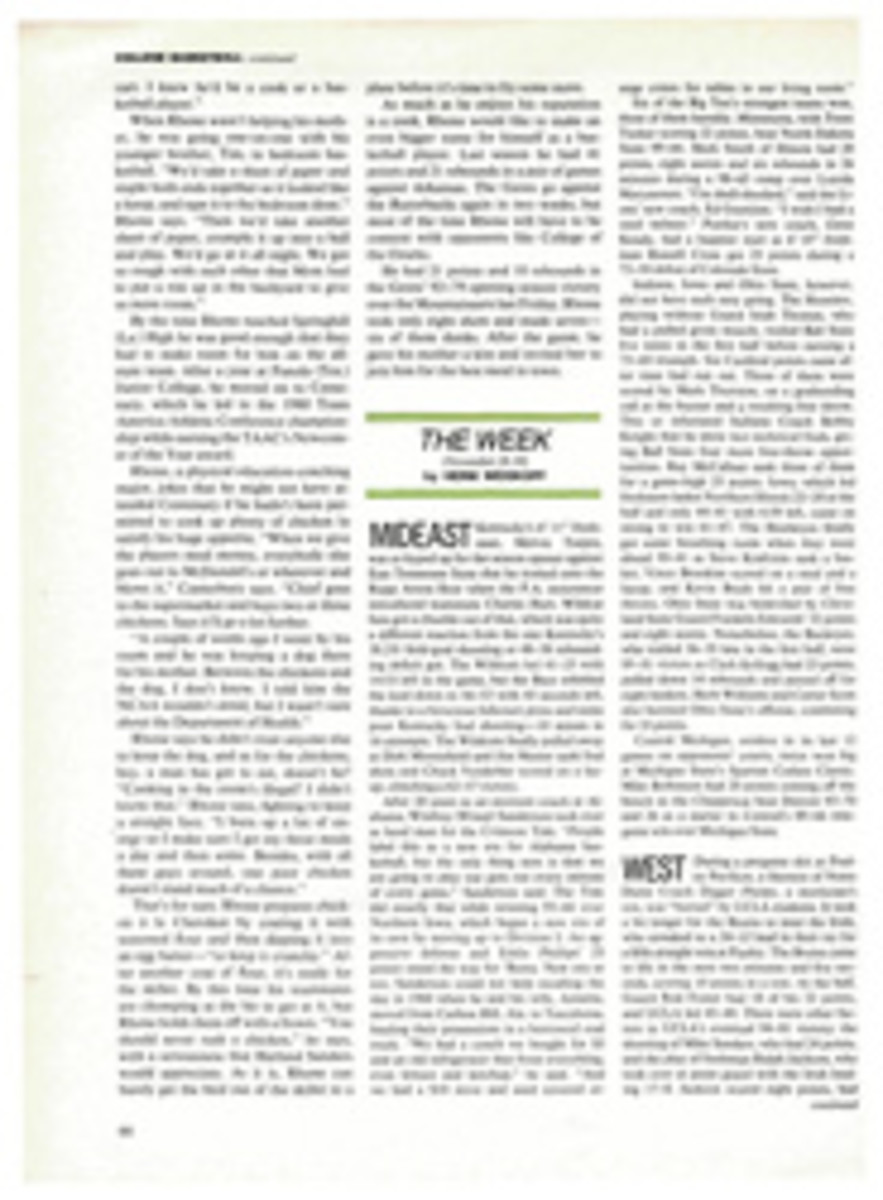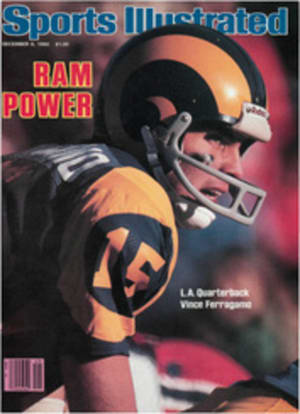
APBA IS THE NAME, BASEBALL IS THE GAME, AND OBSESSION IS THE RESULT
Arn Tellem looks normal enough. He wears crisp khakis and Clark Kent glasses, and a pack of Wint-O-Green Life Savers sprouts from the breast pocket of his Irish linen blazer. In almost every way he seems to be an average young Los Angeles lawyer, but his eyes—impervious to threat or persuasion—give him away. They're the eyes of a fanatic.
The object of Tellem's fanaticism is APBA Major League Baseball, a mail-order game to which about a million Walter Mitty managers have lashed their lives. To its addicts, APBA is a better game of baseball than most people ever see in the Kingdome. "It's more real to me than real baseball," says Tellem, at 26 a veteran of 17 APBA campaigns. "I don't get as excited about anything else as I do about APBA. I'm looking forward to retiring, so I can play all day, every day."
APBA isn't one of those home baseball games in which you try to swat a marble into a hole labeled "double". It's controlled by chance, by omens, by intricate formulas based on a season's statistics. The numbers that come up on a pair of itty-bitty red and white dice correspond with those on performance cards that reflect individual player characteristics: the kinks in Carlton Fisk's throwing arm, Jim Palmer's tendency to serve up taters. These numbers are then plugged into situation charts that take into account more facets of baseball than Earl Weaver does. Games can be called because of rain. Players can be injured, ejected or fooled by the hidden-ball trick (if they're less than 23 years old in the season being played). APBA, it would seem, allows for every possibility except an attack of hemorrhoids to the third baseman.
Serious APBAphiles, whose roster includes not only the likes of Tellem but also real-life ballplayers (Bump Wills and Jim Sundberg, to name two) and at least one owner (Danny Kaye), enter a baseball fantasy world complete with statistics, traditions and history. When playing APBA solitaire, Tellem resembles a bug in a jar, but he's less quiet. He screams. He cackles. He chatters at the player cards. His fingers twitch and wriggle, his elbows slice the air, his hands spin on their wrists like loosely mounted propellers.
And he's quirky. He keeps his tiny dice and shaker in a freezer until game time. "My palms sweat too much," he explains. In a few weeks, Tellem will start making daily phone calls to the APBA factory to find out when the 1981 cards will return from the printer. Then, in early February, he and perhaps a hundred other APBA hadjis will converge on the game's mecca near Millersville, a flyspeck town in Pennsylvania Dutch country. Tellem recalls one of his first pilgrimages to APBA land: "It was February 11, 1967, and I was standing in the lobby of the APBA headquarters when I saw Him." Tellem went slack-jawed with awe; he was in the presence of the APBA deity. "Look," he blurted out to a companion, "there's the Man!" Not Stan, but Richard Seitz, 65-year-old arch-druid of the APBA card cult. Seitz is a trim, compact fellow with a vaguely quizzical expression. It's somewhat tiresome, he says, to be alive in the time of your own legend. "I don't know how to handle it," he admits. "In 1973, at the first APBA convention in Philadelphia, people wanted my autograph, my photo. I didn't know how to respond. It's not like I discovered penicillin or a cure for cancer."
Seitz, who originated the formulas used to make up the player cards, is a fallible god. "Customers write in to argue about performance ratings," he says. "They take it personally. They think they know more about the game than I do." The letters go unanswered.
When APBAchondriacs think of Seitz, they imagine a figure like the Wizard of Oz surrounded by flow charts, scouting reports and crystal balls as he decides how to rate the players. Not so. Though the formulas of the great and powerful Seitz are as closely guarded secrets as the bonus clauses in free-agent contracts, he doesn't figure out player cards anymore. He handed that chore over to an assistant six years ago. He's not even APBA's creator—he came in on the eighth day. The game is modeled after National Pastime, which Seitz played with his buddies in the early '30s. National Pastime folded as fast as a franchise in Schenectady, so Seitz made up his own game, the American Professional Baseball Association, eventually APBA.
In 1951, inspired by the Philadelphia Whiz Kids' pennant, he had some 150 sets of the game printed and marketed them for $10.25 each (these original sets now fetch as much as $1,500 apiece). In 1956, when Seitz was laid off as a purchaser for a trucking firm, he decided to turn pro. Since then he has fashioned APBA editions of football, golf, horse racing, basketball and bowling, but baseball is still the biggest seller. Every year Seitz brings out a new APBA edition for each sport except golf and re-creates a classic year from baseball's past. In 1976, under pressure from APBA's increasingly sophisticated baseball fans, Seitz issued a master game, so complex that he won't sell it to anyone who has owned the basic game for less than six months.
"APBA is the greatest escape mechanism I've ever found." says Thacher Longstreth, president of the Greater Philadelphia Chamber of Commerce and a two-time loser as GOP candidate for mayor. "It makes life bearable. You almost start to live in an APBA world, the world of make-believe." (Republicans seem to have a special affinity for APBA baseball. During the depths of Watergate, David Eisenhower spent as many as four hours a day in his White House bunker with his APBA set. And George Bush has played ever since he became a Congressman in 1967.)
Longstreth belongs to a 13-year-old, 12-team APBA league that's more exclusive than The Union League of Philadelphia. He discovered the game in the mid-'60s while visiting his college-age son, Peter, who was in an academic slump at the time. The father suspected the problem was either girls or booze.
"It's APBA, Dad. You know, A-P-B-A."
"Oh my God," the elder Longstreth gasped. "It's some form of LSD, only worse—it's got one more letter."
It wasn't long before the father was hooked. "It's the most vicious thing that ever happened to me," he says with mock chagrin. "It's worse than a narcotic." Longstreth, whose son no longer plays the game, has as much control over his APBA habit as a knuckleballer has over his pitch on a windy day. "Two members of our league are normal and two are fringe players, but the rest of us have to have APBA."
"There are people who devote 50 to 60 hours a week to the game, and that's really sad," says Bob Henry, a Delaware Law School professor who teaches tax law and studies APBA. Henry writes a question-and-answer column for The APBA Journal, a monthly for APBA junkies with a circulation of 2,500, and he knows nearly every APBA baseball card by heart. APBA code dribbles from his mouth like stock quotations. But his knowledge isn't without drawbacks. APBA freaks have called him at three in the morning to dispute things like Gary Peters' 1966 pitching rating. "It's really bothersome," he says. Especially since he'd just as soon play Strat-O-Matic, one of APBA's many imitators. Strat-O-Matic uses one more die and has actual batting and pitching statistics, besides an arcane rating system, printed on its cards. "That's like admitting the cards have no character," rails Seitz. "It's like having a human being walk around with his IQ stuck on his forehead, instead of letting him show you what he can do. You've got to let the card speak for itself." Indeed, the cards are part of the mystique of the game. "Once you get the cards and hold them," says Tellem, "you transcend the game and become the baseball players themselves. Each card has its own personality."
Alone with his Super League, made up of the best cards from nearly every APBA edition, Tellem will take out his fielder's glove and pretend he's Rogers Hornsby—the card, not the player. When Tellem married, he carried a 1938 Hank Greenberg card as a talisman in the breast pocket of his wedding suit. "I wanted Hank to share in the experience of my life," he says. "It's a mutual relationship—he lets me share in his." Tellem is so nutty about the game that when he flies on business trips, he carries his stats in an attachè case manacled to his wrist. When he's out of his house at night, he always leaves the case open, a precaution against burglars. "They can have the TV, they can have the money, they can have our lives, just please leave the records."
Some APBA fans even get to be like J. Henry Waugh, the obsessed loner in Robert Coover's The Universal Baseball Association, Inc. who invents his own game. Waugh calculates averages, keeps team financial ledgers, oversees life histories and loses his job and, eventually, his mind.
"There's a compensation in APBA that does border on the psychotic," says Seitz, a former philosophy major with a passion for metaphysics. "But it also acts as a fulcrum that people can build their lives around. It lets them relax by giving them a diversion they can become intensely involved in." But Seitz concedes that the line between fandom and fanaticism is as elusive as a ball in the left-field corner at Fenway. "In the '60s a budget analyst from Toledo said he'd never marry because it would curtail the time he spends on APBA. I worry about him, but I appreciate his loyalty."
ILLUSTRATION

